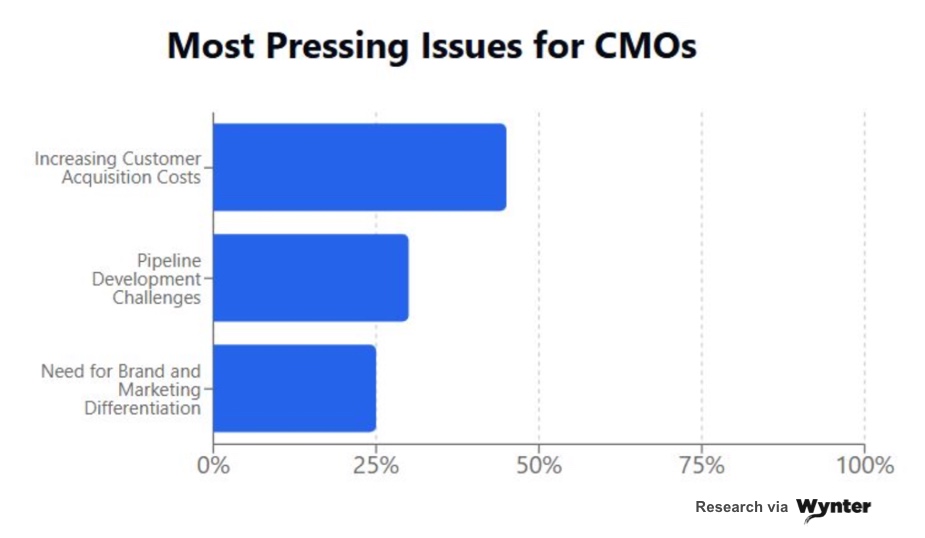
Differentiation has always been a cornerstone of brand and marketing. But the deeper we go into this new era of tech and AI the more your ability to differentiate becomes a true survival skill.
With so many areas of work being enhanced, optimized, or fully automated via AI, the sheer volume of new everything is rising exponentially.
From generative text, image and video, to AI-integrated products, to tools that can now create entire apps from a text prompt.
It all contributes to an era of more:
More content.
More ads.
More brands.
More competition.
A recent poll of CMOs from the research company Wynter shows the impact of this:

The first two issues “Increasing customer acquisition costs (CAC)” and “Pipeline development challenges” are direct symptoms of the third issue:
“Need for brand and marketing differentiation”
When your brand lacks differentiation it’s much harder and more expensive to acquire customers.
Awareness is weak. Sales cycles get longer. The cost per click on ads goes up.
This is why differentiation has to be a top priority for every founder and marketing leader more than ever before.
If you can’t differentiate, the noise will swallow you up.
The bad news is that this wave won’t stop.
The good news is there are ways to rise above it.
Step 1: Audit your current messaging and positioning

To differentiate you first need to audit what’s working and what’s not.
This is why we created our app, SmokeLadder.
SmokeLadder has several features that allow you to quickly analyze your messaging and positioning – and your competitors.
First you can run a Messaging Clarity analysis. This includes a 10 point checklist:
- Target Customer: Does the content call out the target customer for the brand?
- Business Category: Does the content call out the category the brand operates within?
- Offering Definition: Does the content describe in detail what the product or service is?
- Differentiated Value: Does the content articulate the differentiated value of the brand compared to competitors?
- Clear Benefits: Does the content include customer benefit-focused words or phrases?
- Concrete Claim: Does the content make a concrete claim about the value or impact the brand delivers?
- Engaging Message: Does the content crystallize the value of the brand with evocative words or phrases?
- Concise Message: Is the content concise and could it be easily consumed and understood within seconds?
- Vague Words: Does the content avoid vague or ambiguous words or phrases?
- Industry Jargon: Does the content avoid industry or technical jargon or phrases?
After this you can run a value analysis.
SmokeLadder evaluates and scores it across key value points (i.e. save time, organize, increase reach, etc.) to find its biggest strengths and weaknesses.
Together this gives you an outside, objective view on how well your content communicates your unique value today.
Step 2: Use research to assess the exact needs of your customers

If you want your customers to see you as a differentiated option, you have to use research to get to know them – in detail.
It’s not enough if your understanding of your customers comes only from:
- Random anecdotal experiences
- A collection of sales calls
- Third party data
- Gut hunches
- ChatGPT
At best that level of info will get you biased, generalized, surface-level insights. At worst it may send you off in the totally wrong direction.
To deliver differentiated value to your exact audience you need to understand their exact needs.
This means you have to:
- Tease apart their motivations, behaviors, priorities, and language
- Use surveys and interviews of an organized sample of people
- Construct questions that don’t push or lead them
- Ideally get support from sources with running research
We recommend starting with a baseline of:
- A market survey with 200-300 responses (this will get you to 80-90% confidence for even large audience sizes. Go up to 385 for 95% confidence.)
- 10 customer interviews. This is the number where we start to see data saturation – i.e. repeated / redundant responses show up.
The market survey gives you a macro level view to find trends, opportunities, and gaps in the market. It also helps you prioritize customer needs and preferences.
The interviews provide the qualitative layer to help understand customer motivations, buying journeys, emotional drivers, and language.
Together this data paints a picture of what your customers need and where current solutions fall short.
It won’t give you perfect answers but it does reduce the noise and give you clear direction.
Step 3: Establish your differentiated position

Clear, differentiated positioning is built on 3 core pillars.
You have to define and align each pillar with the others in order for your positioning to survive against that massive wave of competition.
Note, these pillars are numbered for a reason – there’s an order of operations here:
1. Customers: Which needs (aka. Jobs to Be Done) do you help solve?
You can fuel this step with the research you did in Step 2. With the insights and data you gathered directly from your customers you can tap into their motivations and satisfy their desired outcomes.
Think about these needs separate from any solutions – including your own.
2. Competition: Where do you create meaningful separation in your category?
Analyze your competitors to find their strengths and weaknesses to maximize your distance from them.
The key here is to evaluate your competitors with a consistent set of criteria. This is where our tool SmokeLadder can provide assistance. You can evaluate any competitor’s key value points and compare against your own brand to find the biggest points of separation.
Your competitors are doing some things well and some not. Your goal is to find the gaps and lean into them.
3. Offering: What value do you deliver at the highest level?
Break down your product or service in terms of the table stakes value you provide (i.e. what most competitors deliver) versus the highlight value (i.e. what you can deliver in a unique way).
Double down on areas where you’re strong and have separation from the competition.
Each pillar has to be clear and aligned with the others in order to differentiate.
Together they create a system of checks and balances to help spot where your differentiation falls short.
- Is this an issue of not knowing what our customers need?
- Is this an issue of not understanding our competitors’ strengths?
- Is this an issue of our product or service not delivering unique value?
Create a differentiated position – and communicate it
Once you complete these steps, you need to communicate your differentiated position consistently across all channels.
This means your website, blog, social content, ads, and sales pitch all need to tell the same story.
Differentiation can only be effective when it resonates with your customers and they can remember it.
Again, your customers get hit with endless offers every day. Without consistency and repetition there’s no way for your specific message to cut through and stand out.
New tech fueled by AI has pushed us into this new era of more.
If you want your brand to not just survive but come out on top of it, differentiation is the key.
Don’t wait for the wave to submerge you – get started now.

Get Help Differentiating Your Brand
If you’re ready to build stronger connections with your customers, reach out for a free consultation. We’ll help you transform your best business thinking into an actionable, shareable, growth-oriented guide. Click below to learn more about the Brand Guidebook process.

